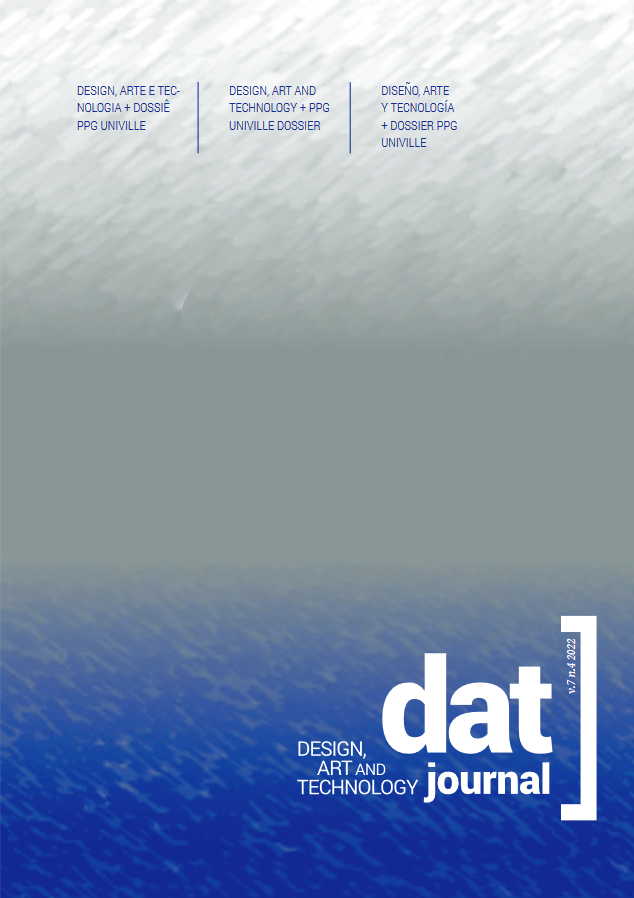Quantitative research in design projects aimed at social inclusion: the use of multivariate analysis
DOI:
https://doi.org/10.29147/datjournal.v7i4.638Keywords:
design, multivariate analysis, social inclusionAbstract
People with some physical, intellectual or sensory impairment have specific needs, which are not always met, generating social exclusion. Design projects can bring benefits capable of assisting in the inclusion of these individuals, as they provide solutions focused on this audience. Thus, not only qualitative techniques can contribute to facing this exclusion, but also quantitative ones, as they allow the generalization of results and the simultaneous analysis of variables. In this article, we investigate design projects that use multivariate analysis techniques aimed at people with disabilities. A systematic review was performed, resulting in nine articles studied in full. The most used technique was multiple regression, which serves to understand user decisions. These articles deal with design projects related to ergonomics, technology, furniture, experiences, products and graphic design. This article discusses the potential that multivariate analysis provides when it is explored in the field of design.
Downloads
References
ACCESSIBILITY and the status of the Convention on the Rights of Persons with Disabilities and the Optional Protocol thereto: Report of the Secretary-General. Nova Iorque: United Nations, ano 2019, 11 jul. 2019. Disponível em https://www.un.org/development/desa/disabilities/resources/general-assembly.html. Acesso em: 09 jul. 2021.
AFACAN, Yasemin; GUREL, Meltem O. Public toilets: an exploratory study on the demands, needs, and expectations in Turkey. Environment and Planning B: Planning and Design. 2015. DOI: https://doi.org/10.1068/b130020p
CAÑETE, F.J. González, et al. Improvements in the learnability of smartphone haptic interfaces for visually impaired users. PLoS ONE 14(11): e0225053. 2019. DOI: https://doi.org/10.1371/journal.pone.0225053
DUPLAGA, Mariusz. Digital divide among people with disabilities: Analysis of data from a nationwide study for determinants of Internet use and activities performed online Technology and Disability. PLoS ONE 12(6): e0179825. 2017. DOI: https://doi.org/10.1371/journal.pone.0179825
EUROSTAT. Europe 2020 indicators–poverty and social exclusion. 2016.
HAIR, Joseph F. et al. Análise multivariada de dados. Tradução de AS Sant’anna e A. Cloves Neto, v. 5, 2005.
HAN, Chunyang, et al. Evaluating the Spatial Deprivation of Public Transportation Resources in Areas of Rapid Urbanization: Discrete Dynamics in Nature and Society. 2019. DOI: https://doi.org/10.1155/2019/6890362
HARADA, F. J. B.; CHAVES, I. G.; CROLIUS, W. A.; FLETCHER, V.; SCHOR, P. O Design Centrado No Humano aplicado: A utilização da abordagem em diferentes projetos e etapas do design. Revista D.: Design, Educação, Sociedade e Sustentabilidade, Porto Alegre, v.8 n.2, 87-107, 2016. DOI: https://doi.org/10.5151/despro-ped2016-http://seer.uniritter.edu.br/index.php/revistadesign/article/view/1449
HENGEN, Johanna; HAMMARSTROM Inger L; STENFELT, Stefan. Perceived Voice Quality and Voice-Related Problems Among Older Adults With Hearing Impairments. Journal of Speech, Language, and Hearing Research. 2018. DOI: https://doi.org/10.1044/2018_JSLHR-S-17-0383
KINOSHITA, Satomi. Handrail position and shape that best facilitate sit-to-stand movement. Journal of Back and Musculoskeletal Rehabilitation. 2012. DOI: https://doi.org/10.3233/BMR-2012-0308
LEBER, M; et al. A study of the impact of ergonomically designed workplaces on employee productivity. Advances in Production Engineering & Management. 2018. DOI: https://doi.org/10.14743/apem2018.1.277
LEVITAS, Ruth, et al. The multi-dimensional analysis of social exclusion. 2007.
MITZUTARI, Kunio, et al. Age-Related Hearing Loss and the Factors Determining Continued Usage of Hearing Aids among Elderly Community-Dwelling Residents. PLoS ONE 8(9): e73622. doi:10.1371/journal.pone.0073622. 2013. DOI: https://doi.org/10.1371/journal.pone.0073622
PFEIFFER, Jens P; PINQUART Martin. Computer use of adolescents with and without visual impairment. Technology and Disability. 2013. DOI: https://doi.org/10.3233/TAD-130373
ROMANI, Elizabeth; HENNO, Juliana Harrison. Reflexões sobre o emprego de técnicas e materiais na construção do acervo tátil em museus. DAT Journal, 2017, 2.1: 134-149. 2017. ROSA, Elisa Conceição da Silva, et al. O uso da análise multivariada em pesquisa no design. Revista Brasileira de Expressão Gráfica. 2017. DOI: https://doi.org/10.29147/2526-1789.DAT.2017v2i1p133-147
TORRES, E. F.; MAZZONI, A. A.; MELLO, A. G. de. Nem toda pessoa cega lê em Braille e nem toda pessoa surda se comunica em língua de sinais. In: Revista Educação e Pesquisa, São Paulo, v.33, n.2, maio/ago, 2007. p.369 - 385. Disponível em: . Acesso em: 20/12/2020. DOI: https://doi.org/10.1590/S1517-97022007000200013
United Nations Development Programme. Human Development Report 2019: Beyond income, beyond averages, beyond today: Inequalities in human development in the 21st century. Nova Iorque: United Nations Development Programme, 2019. 366 p. Disponível em: http://hdr.undp.org/sites/default/files/hdr2019.pdf. Acesso em: 04 mar. 2021.
United Nations. Leaving no one behind: the imperative of inclusive development. Report on the World Social Situation 2016, United Nations Department of Economic and Social Affairs. Nova Iorque: United Nations, 2016. 222p. Disponível em: https://www.worldbank.org/ en/access-to-information. Acesso em: 08 jul. 2021.
VENKATACHALAM, S.; VARGHUESE, K. Análise dos fluxos de trabalho de projetos na índia. Gestão & Tecnologia de Projetos, [S. l.], v. 5, n. 3, p. p. 85-103, 2010. DOI: 10.4237/ gtp.v5i3.176. Disponível em: https://www.revistas.usp.br/gestaodeprojetos/article/ view/79519. Acesso em: 09 jul. 2021.
VIANNA, William Barbosa. O design da pesquisa qualitativa: questões a considerar. In: SIMPEP, 13.,2006, Bauru. Anais... Bauru: SIMPEP, nov. 2006. p.1-4.
VICINI, Lorena. Análise multivariada da teoria à prática. Santa Maria: UFSM, CCNE. 2005.
World Health Organization (org.). Life expectancy and Healthy life expectancy Data by country: Data by country. 2018. Disponível em: http://apps.who.int/gho/data/view.main. SDG2016LEXv?lang=en. Acesso em: 04 mar. 2021
Downloads
Published
How to Cite
Issue
Section
License
Copyright (c) 2022 DAT Journal

This work is licensed under a Creative Commons Attribution 4.0 International License.


























